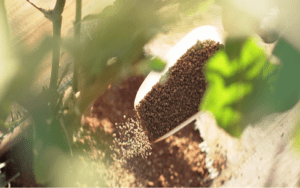Manganese: What it offers as a fertilizer to plants and crops
Although less well known, manganese (Mn) is a valuable trace element for plants to have vigorous green growth and abundant fruit production.
When we refer to the term “trace elements”, we mean the nutrients that plants and crops need in small amounts such as iron, boron, zinc and copper.
Manganese is a trace element that moves quite hard inside the plant and its deficiency is usually observed in the first developed leaves.
In order to detect the lack of manganese in crops in time, it is important to know the initial symptoms of the deficiency, but also to analyze the soil and friends in special laboratories.
Correcting the problem of manganese deficiency, or manganese malnutrition as it is called, is achieved by adding appropriate manganese fertilizers to the soil or by spraying the crops with manganese foliar fertilizers.
In today’s article, we will see in detail what manganese offers to plants and crops, what problems manganese deficiency creates and which manganese fertilizers to add to plants for lush vegetation and good fruiting.

- What does manganese do for plants and crops? Manganese has an important role in the natural functioning of the metabolism and photosynthesis of plants, as it participates in the activation of many enzymes. Sufficient amount of manganese in plants helps in rapid germination and growth of the plant. In addition, it contributes to the creation of green vegetation, as it has a critical role in the utilization of nitrogen and iron.
- Which crops are deficient in manganese? Manganese malnutrition is observed in the cultivation of olives, in apple trees, i.e. in the cultivation of apples and in the cultivation of pears, as well as in citrus fruits, such as in the cultivation of oranges, in the cultivation of tangerines and in the cultivation of lemons. In addition, manganese deficiency also occurs in grape cultivation in both table and wine-making grades as well as in kiwi cultivation. Among horticultural crops, manganese deficiency is observed in potato crop, tomato crop, pepper crop, eggplant crop and melon crop.
- What are the symptoms of manganese deficiency and when does it occur? The symptoms of manganese deficiency appear in the new leaves of the plants with characteristic yellowing between the ribs that retain the green color. At the same time, the lack of manganese in plants is characterized by less shoot growth, limited and degraded flowering and less fruit production. Manganese deficiency in plants often occurs in alkaline soils with a high pH, in soils that are high in manganese, in soils that have a high content of organic matter or a nutrient such as phosphorus, iron, calcium or boron. Manganese deficiency can be observed in crops and in conditions of increased soil moisture due to poor drainage or due to sudden rains and floods.
- What manganese fertilizers do we choose for our crop? Adding manganese to the soil can be done by adding manganese sulfate fertilizer in granular form or by adding magnesium sulfate in crystalline form, suitable for application by sprayer through the irrigation system. For more immediate absorption of manganese by the plants, we can spray the foliage of the crop with liquid or water-soluble manganese fertilizers.
- And a secret about manganese in plants and crops. Excessive manganese fertilization, especially in acidic soils with low pH, can cause plant toxicity manifested by yellowing of older leaves and reduced root system development.

